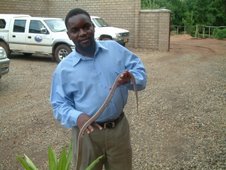
Get to know more about Mount MULANJE
by Hastings Maloya
Introduction
Mt. Mulanje is located 65 km east of Blantyre, Malawi’s commercial city. The view of Mt. Mulanje when driving from Blantyre is superb provided the weather is clear. Mulanje is a vast, isolated granite massif rising sharply and dramatically above the Phalombe Plain southeast of Blantyre. The massif covers an area of 650km2, and largely comprises a plateau of rolling grassland averaging around 2,000m in altitude. This plateau is incised by several thickly wooded ravines, while rising above it are 20 peaks that reach an altitude of over 2,500m. One of these, Sapitwa Peak, is at 3,002m the highest point in Central Africa.
Several different vegetation types cover Mulanje. The lower slopes of the massif, where they have not been planted with exotic pines and eucalyptus, are covered in closed-canopy woodland. The main vegetation type of the plateau is not dissimilar in appearance to the alpine moorland found on East Africa’s larger mountains: a combination of heathers, heaths and grasses. There are supporting a wide array of wild flowers, including various helichrysums, irises, lobelias and aloes, a large number of which are endemic to the mountain.
Evergreen woodland and forest is largely restricted to ravines and watercourses. The most notable forest tree on Mulanje is the endemic Mulanje cedar (Widdringtonia whytei), a magnificent timber tree which can reach a height of over 40m. Mulanje’s cedars have been depleted in the last century due to timber felling, but several impressive stands remain, the most accessible of which lies in the saddle southeast of the Chambe Basin and includes many trees that are thought to be over 300 years old.
In the open highlands, the only mammal species seen with any regularity are klipspringer, rock hyrax, red rock hare and vole. In the woodlands of the lower slopes and in forested areas, there is a good chance of seeing vervet and samango monkeys. Red duiker, bushbuck, leopard, bushpig and porcupine are also present in wooded habitats.
With easy access from Blantyre, well-organised and inexpensive facilities, and some of the most dramatic scenery in the country, Mulanje is Malawi’s premier hiking and rock-climbing destination, popular with tourists and expatriates alike. There are several routes from the base to the plateau, but the only ones that are used with much regularity are the Skyline Path to the Chambe Basin and the Lichenya Path to the Lichenya Plateau. Both of these routes start at Likhubula Forestry Station, which lies at the eastern base of the mountain about 10km from Mulanje Town.
In addition to there being inexpensive accommodation at Likhubula Forestry Station, there are nine huts on the plateau, connected to each other by well-marked trails ranging from three to six hours’ walking duration. With 20 peaks to explore, Mulanje has enough walking and climbing potential to keep anybody busy for at least a month
Guides and porters
We are very proud that the guides and porters of Mulanje are very organised. At each entrée point to the go up Mt. Mulanje is a guides and porters branch present. The guides have knowledge about the area and some are even specialist in birds and wildlife.
The porters work on a rotation schedule. Therefore is it very important that you collect your porters from the entrance points, especially in Likhubula. The rotation schedule was designed as a countermeasure against hassling from not registered guides and porters. Please take notice of this and use only guides and porters from the designated offices.
Safety
It is important to bear in mind that rescue services are virtually non-existent. If you decide to climb a peak do sign the hut destination book and tell the watchmen, guide, porter of your plans. Remember that days often change on Mulanje from gorgeous clear mornings to misty, cloudy weather when route finding conditions become very different. Dry rocks quickly become very slippery. Flash floods and dangerous river crossings feature the rainy season. This does not mean you cannot hike Mt. Mulanje. When you do take precaution. I advise to take at least one guide or porter with you. Guides and porters all have had medic first aid training.
Interesting sights around the base of Mt. Mulanje
There is a road along the whole of the base of Mt. Mulanje. All the entrance points have their own interesting points to see, if a group does not want to hike the mountain or has half a day to a day left. These include pools near Likhubula and Lujeri, a hydro system near Lujeri, an old graveyard site near Fort Lister, real African villages near all entrance points and many more.
InfoMulanje
InfoMulanje is our local information office. Here you can make bookings for all accommodations and restaurants around Mt. Mulanje. Furthermore they organise tea-tours in one of the nearby tea-estates, which gives you more inside in the tea making process. It even includes a factory visit!
InfoMulanje can give you on the spot information about day trips to other interesting sights around the base of Mt. Mulanje.
InfoMulanje is located in Mulanje Chitakale, where the main Trading centre is and the turnoff to Likhubula. The Turnoff is easily recognisable by Pizzeria Bassilica. On top of the pizzeria is the InfoMulanje office.
Contact details:
InfoMulanje
Manager: Mss. Emmie Suliwa
Tel: (+265) 01 466 466
PO Box 200, Mulanje
Email: infomulanje@mountmulanje.org.mw or infomulanje@sdnp.org.mw








No comments:
Post a Comment